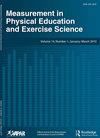Development of Criterion-Referenced Standards for Musculoskeletal Fitness in Youth: Considerations and Approaches by the FitnessGram Scientific Advisory Board
IF 1.9
4区 教育学
Q2 EDUCATION & EDUCATIONAL RESEARCH
Measurement in Physical Education and Exercise Science
Pub Date : 2022-01-05
DOI:10.1080/1091367X.2021.2014331
引用次数: 5
Abstract
ABSTRACT The FitnessGram program has prioritized the use of evidence-based, criterion-referenced standards to advance health-related fitness assessments in physical education. The Institute of Medicine (IOM)1 highlighted the importance of strength and power for youth fitness assessment and surveillance. The report specifically recommended the use of handgrip and long-jump, but a barrier to adoption was the lack of criterion-referenced standards to categorize and evaluate performance. The purpose of this paper is to provide an overview of a multi-faceted research initiative focused on advancing research on musculoskeletal fitness assessments in youth. The report chronicles the concepts, approaches, and considerations that shaped the plans for this large-scale research effort aimed at developing robust criterion-referenced fitness standards for these assessments.青少年肌肉骨骼健康标准参考标准的制定:FitnessGram科学咨询委员会的思考和方法
FitnessGram计划优先使用循证、标准参考的标准来推进体育教育中与健康相关的健身评估。医学研究所(IOM)强调了力量和力量对青少年健康评估和监测的重要性。该报告特别建议使用手握和跳远,但采用的一个障碍是缺乏标准参考的标准来分类和评估表现。本文的目的是提供一个多方面的研究倡议的概述,重点是推进研究在青年肌肉骨骼健康评估。该报告记录了概念、方法和考虑因素,这些概念、方法和考虑因素塑造了这一大规模研究工作的计划,旨在为这些评估制定可靠的标准参考健身标准。
本文章由计算机程序翻译,如有差异,请以英文原文为准。
求助全文
约1分钟内获得全文
求助全文
来源期刊

Measurement in Physical Education and Exercise Science
Medicine-Orthopedics and Sports Medicine
CiteScore
4.20
自引率
33.30%
发文量
24
期刊介绍:
The scope of Measurement in Physical Education and Exercise Science (MPEES) covers original measurement research, special issues, and tutorials within six substantive disciplines of physical education and exercise science. Six of the seven sections of MPEES define the substantive disciplines within the purview of the original research to be published in the journal: Exercise Science, Physical Activity, Physical Education Pedagogy, Psychology, Research Methodology and Statistics, and Sport Management and Administration. The seventh section of MPEES, Tutorial and Teacher’s Toolbox, serves to provide an outlet for review and/or didactic manuscripts to be published in the journal. Special issues provide an avenue for a coherent set of manuscripts (e.g., four to five) to collectively focus in-depth on an important and timely measurement-related issue within the scope of MPEES. The primary aim of MPEES is to publish high-impact manuscripts, most of which will focus on original research, that fit within the scope of the journal.
 求助内容:
求助内容: 应助结果提醒方式:
应助结果提醒方式:


